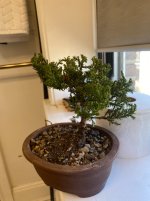Hi
I received this juniper bonsai as a gift. I live in zone 7b NYC and I've kept it outside to get sunlight for 5-6 hours a day. Sometimes in the windy nights i bring it back outside but keep it by the window so it's not too hot. I water fully 1-2x a week and mist every day. The branches are now starting to get very prickly and brittle and fall at the slightest touch. The inside of the bark is still bright green so I'm hopeful?
I don't know what I'm doing wrong and would really appreciate some guidance. I've attached photos for reference. The before photo was just 3 weeks ago.
I received this juniper bonsai as a gift. I live in zone 7b NYC and I've kept it outside to get sunlight for 5-6 hours a day. Sometimes in the windy nights i bring it back outside but keep it by the window so it's not too hot. I water fully 1-2x a week and mist every day. The branches are now starting to get very prickly and brittle and fall at the slightest touch. The inside of the bark is still bright green so I'm hopeful?
I don't know what I'm doing wrong and would really appreciate some guidance. I've attached photos for reference. The before photo was just 3 weeks ago.




